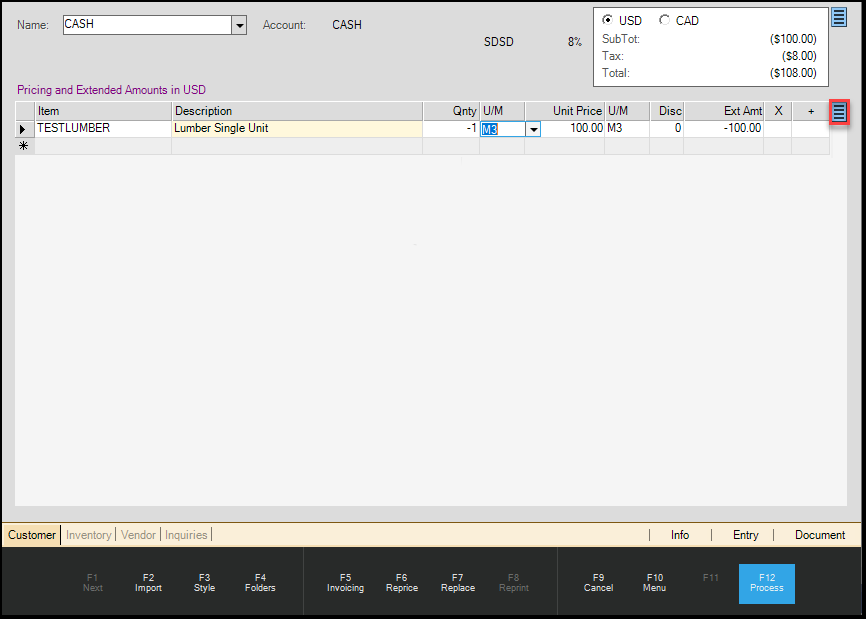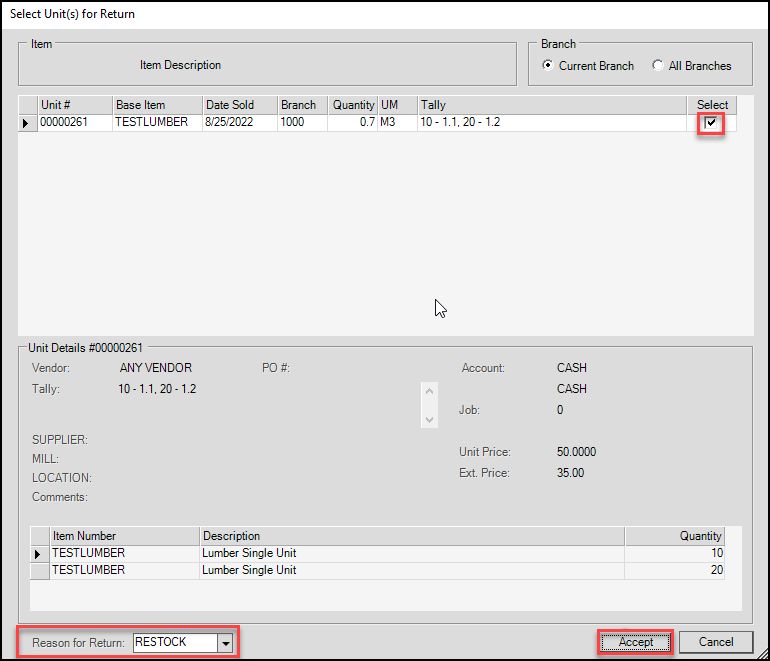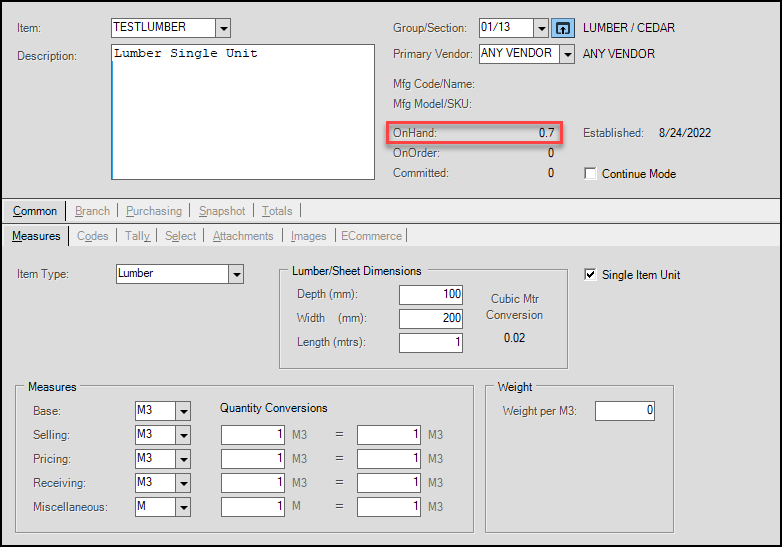Tally Items
There are a number of types of "tally" items. This topic explains what types are available as well as how they are used. Currently, we offer
Setting Base Quantities for Tally Items
When quantifying tally items, it's best to have the BASE be the smallest unit quantity used to order or sell the item by. Why? For quantities and pricing, the application maintains decimal values out to four decimal places (0.0001), and uses the BASE unit for converting most measurements. Four decimal places can be less precise when converting a larger figure to a smaller one, so if you are starting with a smaller figure (no decimal places needed), it's easier to convert up and maintain greater accuracy. Unit of Measure settings (set in Branch > Codes) allow you to change to how the application applies units of measure under different circumstances (such as Point of Sale or Receiving). You can choose one Unit of Measure for quantities at Point of Sale and a different measure for quantities used when receiving inventory.
Pull to Length
A "pull to length" tally is typically used with items sold by length (molding/trim, etc.). With this tally type, a list of items (child/member items) is linked with the tally item. Each item would represent a different length of the same item. Child (member) items are actual items and can be sold/received independently from the tally they are linked with. These child/member items normally maintain on-hand and other quantities and have their own pricing. In this case, the tally item is used temporarily for selection only. Once selection is completed, the member/child items replace the "tally" in the item grid.
Random Length
A "random length" tally involves a single item that is sold by length (lineal foot, for example). There are no child items in this case. This type of item is used when an product is sold in varying lengths and only one SKU is maintained for that item. This could also be used for molding or any other item sold based upon varying lengths. Random length tallies require entry of quantities and lengths by the user. These are used to calculate the total length being sold. An overall on-hand is maintained for this type of item. There is no record maintained for the individual quantity-lengths, these figures are only used when calculating a total quantity (for sale, receipt, etc.).
Fixed Length
The "fixed length" tally is linked with child (member) items similar to the "pull to length" type but also has similarities to the "random length" tally. In this case, the tally item determines pricing, not the member items -- and -- the member items do not replace the tally SKU in the item grid (child items are hidden from view and referenced as quantity-length comments in the Tally item's description). The members of this type of tally are still independent items which may be sold or received on their own.
Lot/Location
This type is significantly different from the other types and is used in cases where a single item must be grouped into distinct units. This tally type was designed to be used with brick. Due to variations as a result of manufacturing, a particular brick product can vary in appearance despite the fact that the brick is technically the same product/type. For this reason, grouping and tracking bricks that match can be important. This tally type offers a way of tracking different "lots" which represent brick (or other goods) that were manufactured together. In addition, this tally type provides a way of designating the location where quantities of each lot are located (display area vs. brickyard, etc.).
Sheet Metal
The "Sheet Metal" type allows the user to enter either a total lineal quantity or detailed quantity-lengths similar to a random length tally. The only difference from the random length type is that sheet metal lengths may be entered using both feet and inches. The length in feet and inches is listed on printed documents (assuming detailed quantity-lengths were specified); however, the overall quantity is recorded as a decimal (for example, 1 - 1' 3" piece of sheet metal would show an overall quantity of 1.25). There are no child items with this type of tally, so the intended use for this type is for cases where the same product is sold in varying lengths (where length is the only dimension or quality of the product that differs). It would be necessary to define a separate sheet metal item for each variety. Typically, a sheet metal tally would be assigned a default unit of measure of square foot.
Lineal
A lineal tally combines some of the features of the lot/location, sheet metal, and fixed length types. Lineal tallies are comprised of user-defined preset lengths which are not items, but maintains limited information regarding quantities for each length defined. A custom or "cut" length may also be defined allowing for odd sizes and special orders. Preset lengths must be received in full lengths; however, they can be "cut" at Point of Sale and priced either by the cut length or the full length the cut was made from. These tallies may be used with purchasing and receiving, physical counts, and most Point of Sale transactions that involve item-entry (sales, orders, direct ship, etc.).
Hardwood Tally
This type of tally is provided for the sale of exotic hardwoods which are generally sold in small quantities to hobbyists, but could be applied to other product types if they have the same requirements. Often, these woods are available in a number of different species as well as dimensions. The purpose of this tally is to sell a variety of sizes using a single item SKU. Since hardwoods can vary in price, each species and depth would be its own unique tally. Depth is the one constant dimensional value with this type of tally. This is necessary if pricing is assigned to the tally item.
U/M Tally
A "U/M" or Unit of Measure Tally involves a single item allowing a tally involving quantities for more than one of the item's measures. For example, if an item was sold by the pallet, case, and individual pieces, you could have a tally where quantities of each unit are represented as a single line item in a transaction.
Unit Tally
This type of tally is provided for use with bulk wrapped, banded, or otherwise packaged materials that come with some variance based on one or more dimensions. Standard, lumber (timber), and sheet goods items are eligible for Unit Tally use. New units can be created and existing units may be split into component products as needed.
Returning Single Unit Tally Items to Stock
A customer reported that they were having trouble handling returns of single unit tally items (standard, lumber/timber, sheet goods, and hardwoods). We have created the following process to facilitate these kinds of returns and make returned single unit tally items available for sale again. Items returned using this process are visible in the OnHand field of the Item Maintenance form for the item. To be clear, this process allows the return of multiple single unit tally items, we are just going to show you the process here.
To process a return for a single unit tally item:
1. From the Main Menu, choose Point of Sale > Sales to display the Sale Entry form.
2. Enter the single unit tally item into the data grid and enter the negative quantity in the Qty field.

Sale Entry with Negative Quantity Single Unit Tally Item in Data Grid
3. Right-click the Menu Marker  beside the data grid to display the context menu.
beside the data grid to display the context menu.

Sale Entry Data Grid Context Menu
4. Choose the Return Units option in the list. The Select Unit(s) for Return box displays.

Select Unit(s) for Return with Required Actions Highlighted
5. Choose the Select check box to return this item to inventory.
6. In the Reason for Return list, choose the reason the customer is returning the item.
7. Click Accept to continue. The Sale Entry form redisplays.
8. Choose Process (F12) to process this return. Follow the typical protocol for finishing the transaction. When you look up the item in Item Maintenance, the item is replenished in the OnHand field.

Single Unit Tally Item Returned to Stock